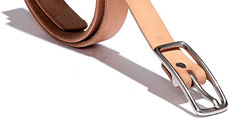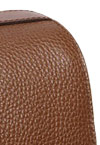The Essential Leather Glossary
There's a lot of jargon when it comes to leather. Which is why we put together these easy to understand explanations
of the industry terms you'll likely encounter when shopping for quality leather goods.
Vegetable Tanned cowhide used for making equestrian equipment.

Deer or sometimes elk skin leather.
Skin from the domesticated water buffalo (and not the American bison).
A polishing technique where heat is generated resulting in a unique, darker surface shine.
Loafers, $475 by Ralph Lauren
A high quality, fine grained leather made from the skins of young cattle.
Also known as "shell cordovan," this leather is made from the firm shell portion of a horse (read: the butt). Cordovan has a characteristic finish, and is very durable.
Outside skin that's been smoothed with sand paper to minimize flaws, then pigment-dyed and embossed.
Like with raw denim, this is when the dyes or finishes rub off onto other materials.
Leather that has not been corrected in any way, beyond the original hair removal, allowing the natural markings and character of the leather to show through. Full grain leathers must be cleaner hides to start with, making them more expensive.
Lambskin or other very soft, high quality leathers typically used for gloves.

A term used to describe the natural characteristics of an unprocessed hide, such as its texture, wrinkles and markings.
The Horween Leather Company is one of the oldest continuously running tanneries in the US. They offer a variety of pigments and tannages, utilizing primarily cowhide and horsehide along with some bison as well.

Soft, full grain leather made from unsplit sheep or lambskin. It is usually tanned with alum and chromium salts and dyed throughout the whole piece.
A leather where the surface has been buffed and brushed to create a soft, velvety effect. While suede is created from the flesh (inner) side of a hide, nubuck is created using the grain (outer) side, making it stronger.
Leather that is tanned using oils to create a very soft, pliable finish.
A dark, reddish-brown color used to dye leather, and is used often for cordovan.
Leather, one surface of which is covered with a flexible, waterproof film which has a lustrous mirror-like surface. This coating was formerly built up by the application of various varnishes and lacquers using linseed oil. The original process was developed in New Jersey, by inventor Seth Boyden in 1818. Today, patent leather
usually has a plastic coating.
The rich, worn-in hue or luster that develops in a quality piece of leather over time with age and wear.
Describes the behavior of leather that has been treated with oils, waxes and dyes so that when the leather is stretched (or pulled), the finish becomes lighter in those areas. Horween's Chromexcel is an example.
Sheepskin or lambskins that have been tanned with the wool intact.
The underneath layer of side leather which has been "split" off. Devoid of a natural grain, it may be either sueded or pigment finished and embossed.
A finish (not technically a type of leather) where the top surface of the hide has been removed by abrasion and then brushed to create a soft, fuzzy feel. Also known as buffed leather, similar to nubuck.

A method of hide tanning which utilizes materials from organic materials such as bark, instead of the traditional chemicals. Vegetable tanned leather is stiffer than traditionally-tanned leather, and gets darker from your body's natural oils the more you use it.
Belt, $92 by Billykirk
© Copyright 2024 Degitao Technology Pvt. Ltd - All Rights Reserved. | Privacy Policy | Terms & Conditions
